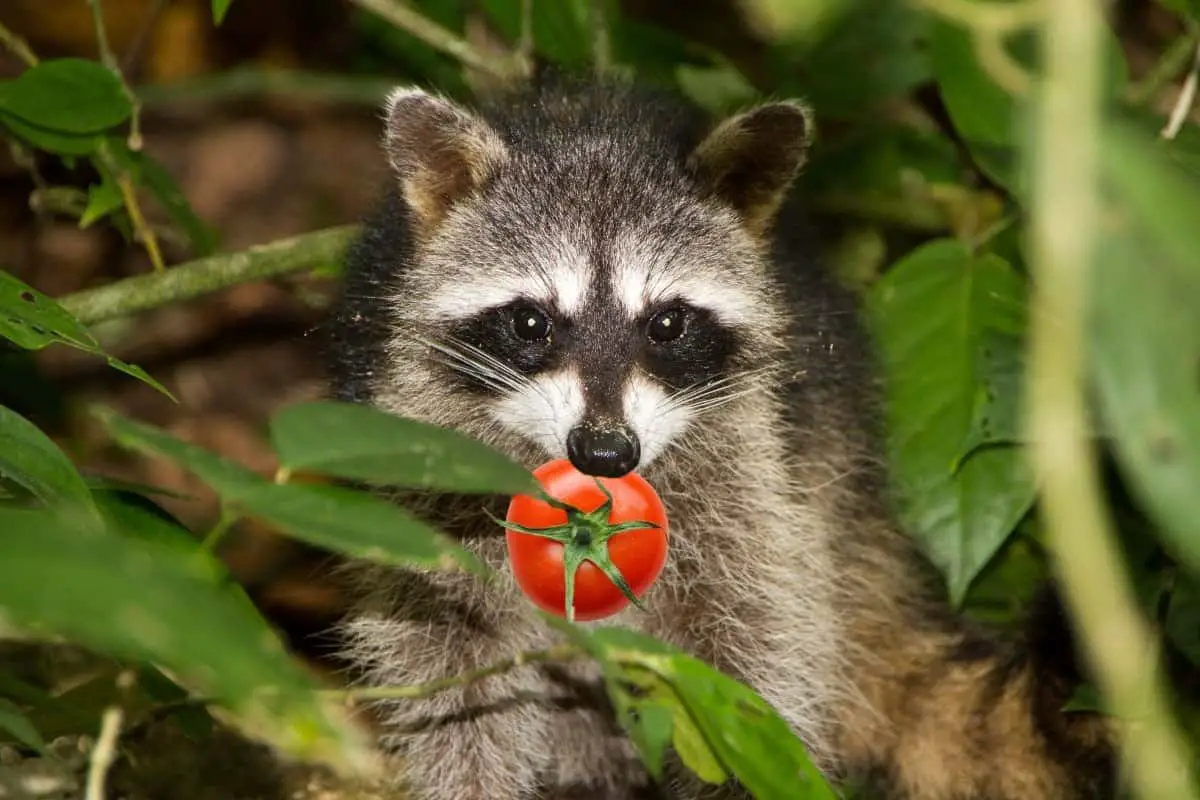Last Updated on December 12, 2021 by Cristina
Growing and maintaining your own garden means that you have to deal with pests, making many gardeners ask “Do raccoons eat tomatoes?” These animals are very well known for stealing from the trash and eating basically anything, which can make them a difficult opponent in your everyday gardening life! However, even though they can deal your plants some damage, there are ways to deal with them.
In today’s article, we’ll be taking a closer look at animals that could be harming your plants and ways to protect your garden!
What Animals Eat Tomatoes?
If you’re asking yourself “What is eating my tomatoes at night?” – know that the answer can’t be definitive. There are many animals that can’t wait to get their fingers (or beaks) on your tomatoes.
Depending on your location, the animal eating your tomatoes could be: a raccoon, a bird, a squirrel, a chipmunk, a deer, with some other candidates, too.

It’s very unlikely that your neighbor’s dog or a cat is eating your tomatoes, as they prefer meat and will usually stay away from vegetables. These animals will likely wait for you to get lost before they approach your garden. Raccoons are especially dexterous in this way, and they’re not afraid to come back even if you chase them off once!
There are, however, ways for you to defend your garden from pests!
Protecting Your Garden From Pest
There are numerous things we can advise you to do to protect your garden from pests. It’s important to know, however, that different animals have different abilities and there’s no universal protection. Birds, for example, will simply fly over fences, while squirrels will climb over them. Combining different methods of protection is going to be the most effective solution!
Install A Fence
If you ask any gardener anywhere around the world – this is going to be their primary piece of advice. The most effective way to get rid of pests is to install a fence. This will neutralize deer and other animals, like rabbits. There are a few conditions your fence must meet if you want it to hold up.
Firstly, no fence below at least 6 feet is going to stop a deer. They’re jumping animals and they can easily jump over a low fence. Secondly, there are many burrowing animals that find your tomatoes tasty. That’s why your fence should be buried at least a foot into the ground! Also, you should make sure that your fence is strong. Metal fences that aren’t yielding are the best option.
Origin Point Garden Zone 36 Inches x 50 Feet 16-Gauge Green Vinyl Coated Garden Fence
Combine the fence with a natural animal repellant like predator urine for maximum efficiency. These repellants usually have an active ingredient that’s naturally threatening or smelling bad to many animals. Predator urine, for example, smells like wolf urine – deer and rabbits will naturally stay away from it!
Use A Repellant
You can use both store-bought and homemade repellants to deter animals. A popular homemade repellant is a hot sauce – when mixed with water and soap, it’s going to hurt any animal who dares eat your plants, while it won’t harm the plant. The idea is that the animal will learn not to eat the plant because of the spiciness.
You can also buy natural repellants. We already mentioned wolf urine, but repellants also work on the basis of smell – animals won’t approach something that smells nasty to them.
There is a con to using repellants – you have to reapply them after every rain. Even if it doesn’t rain, you have to reapply them every two weeks. This isn’t too much of a job, but it’s definitely a chore to keep in mind.
Scare Them Off
Animals avoid humans by nature, which is why scarecrows are so often a useful solution, especially when it comes to birds. Combining a scarecrow with a radio or something else that’s going to produce noise. Animals don’t like unnatural noises, and when you join those noises with a very real-looking scarecrow, animals will assume that there’s a person in the garden.
There are even systems that use sensors connected to a speaker, producing a high-pitched noise when they detect an intruder. Similar systems use sprinklers to scare the intruder away with water.
Cover Your Plants
This might as well be the most effective method alongside installing a fence around your garden. Covering your plant with a mesh or a garden fabric can go a long way when it comes to protecting your plants. This is actually a common practice in vineyards, as plants are covered with a (usually green) fabric that’s supposed to keep the birds away. Most animals can’t penetrate through these fabrics, so they’re a very good form of protection, especially for younger plants.
Read more about What To Cover Plants With From Freezing Temperatures
Get A Dog
There are many dog breeds which are protective over their territory by nature. Dachshund, for example, even though they’re a small species, can make for an incredible guard! If you let a dog back into your garden and you teach it to protect it, there’s very little chance of any animal eating your plants. Even a small guard dog like a dachshund can scare off a larger animal, like a deer.
There are two things that you have to take into account when you’re thinking about getting a dog. Firstly, you need to train and care for this dog. Secondly, it’s likely that the dog will constantly step onto your plants, likely damaging them. Even if you try to train it not to, your dog needs to get close to the plant to scare the animal away.

Conclusion
To sum up, a raccoon eating tomatoes is definitely a possibility as they’ll eat almost anything. They aren’t, however, the only animal that’s possibly invading your garden! Deer, rabbits, birds, squirrels, groundhogs, and other animals could all be eating your fruits and vegetables. The best way to protect your garden from these critters is to install a fence, use natural animal repellants and try to scare them off by any means necessary.
You could also use plant covers or get a dog. The best solution to your critter problem would be combining all of these methods!


